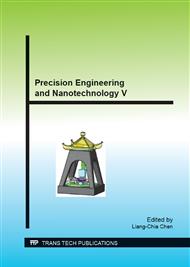p.360
p.366
p.372
p.378
p.384
p.392
p.398
p.402
p.411
Performance of the Partially Porous and the Fully Porous Aerostatic Journal Bearings with Incompressible Air Flow
Abstract:
This report presents a study on the performance of the fully porous and the partially porous aerostatic journal bearings. Based on the finite volume method and the pressure-velocity coupling scheme of the SIMPLE algorithm with the standard k-ε turbulent model, this study utilized the CFD software to solve the incompressible three dimensional Navier-Stokes equations to calculate the pressure of the flow field in the bearings. The effects of the size of the porous medium, the bearing gap, the eccentric ratio and the rotational speed of the spindle on the characteristics of the bearing such as the pressure distribution, the load carrying capacity and the stiffness were investigated. The computed results revealed that, when the spindle rotated at high speed, the effect of the dynamic pressure became dominant, while the effect of the static pressure became insignificant. Among the three types of journal bearings under investigation, the partially porous aerostatic journal bearing exhibited the highest ratio of output pressure to air volume flow rate. It indicated that, in terms of operational efficiency, the partially porous aerostatic journal bearing is superior to the fully porous aerostatic journal bearing.
Info:
Periodical:
Pages:
384-391
Citation:
Online since:
August 2014
Authors:
Price:
Сopyright:
© 2015 Trans Tech Publications Ltd. All Rights Reserved
Share:
Citation:


